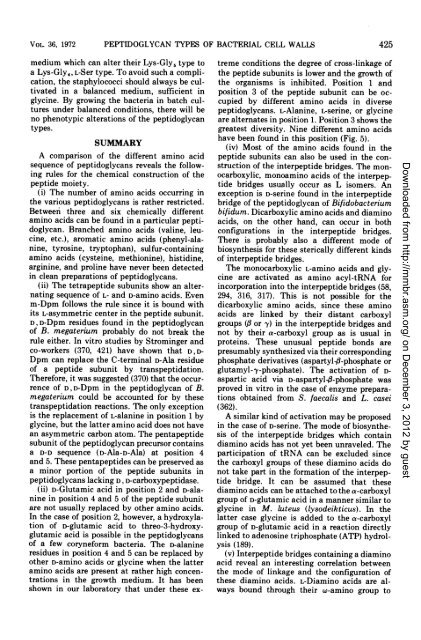Peptidoglycan .Types of Bacterial Cell Walls and their Taxonomic ...
Peptidoglycan .Types of Bacterial Cell Walls and their Taxonomic ...
Peptidoglycan .Types of Bacterial Cell Walls and their Taxonomic ...
Create successful ePaper yourself
Turn your PDF publications into a flip-book with our unique Google optimized e-Paper software.
VOL 36, 1972 PEPTIDOGLYCAN TYPES OF BACTERIAL CELL WALLS<br />
425<br />
medium which can alter <strong>their</strong> Lys-Gly5 type to<br />
a Lys-Gly4, L-Ser type. To avoid such a complication,<br />
the staphylococci should always be cultivated<br />
in a balanced medium, sufficient in<br />
glycine. By growing the bacteria in batch cultures<br />
under balanced conditions, there will be<br />
no phenotypic alterations <strong>of</strong> the peptidoglycan<br />
types.<br />
SUMMARY<br />
A comparison <strong>of</strong> the different amino acid<br />
sequence <strong>of</strong> peptidoglycans reveals the following<br />
rules for the chemical construction <strong>of</strong> the<br />
peptide moiety.<br />
(i) The number <strong>of</strong> amino acids occurring in<br />
the various peptidoglycans is rather restricted.<br />
Between three <strong>and</strong> six chemically different<br />
amino acids can be found in a particular peptidoglycan.<br />
Branched amino acids (valine, leucine,<br />
etc.), aromatic amino acids (phenyl-alanine,<br />
tyrosine, tryptophan), sulfur-containing<br />
amino acids (cysteine, methionine), histidine,<br />
arginine, <strong>and</strong> proline have never been detected<br />
in clean preparations <strong>of</strong> peptidoglycans.<br />
(ii) The tetrapeptide subunits show an alternating<br />
sequence <strong>of</strong> L- <strong>and</strong> D-amino acids. Even<br />
m-Dpm follows the rule since it is bound with<br />
its L-asymmetric center in the peptide subunit.<br />
D, D-Dpm residues found in the peptidoglycan<br />
<strong>of</strong> B. megaterium probably do not break the<br />
rule either. In vitro studies by Strominger <strong>and</strong><br />
co-workers (370, 421) have shown that D,D-<br />
Dpm can replace the C-terminal D-Ala residue<br />
<strong>of</strong> a peptide subunit by transpeptidation.<br />
Therefore, it was suggested (370) that the occurrence<br />
<strong>of</strong> D,D-Dpm in the peptidoglycan <strong>of</strong> B.<br />
megaterium could be accounted for by these<br />
transpeptidation reactions. The only exception<br />
is the replacement <strong>of</strong> L-alanine in position 1 by<br />
glycine, but the latter amino acid does not have<br />
an asymmetric carbon atom. The pentapeptide<br />
subunit <strong>of</strong> the peptidoglycan precursor contains<br />
a D-D sequence (D-Ala-D-Ala) at position 4<br />
<strong>and</strong> 5. These pentapeptides can be preserved as<br />
a minor portion <strong>of</strong> the peptide subunits in<br />
peptidoglycans lacking D, D-carboxypeptidase.<br />
(ii) D-Glutamic acid in position 2 <strong>and</strong> D-alanine<br />
in position 4 <strong>and</strong> 5 <strong>of</strong> the peptide subunit<br />
are not usually replaced by other amino acids.<br />
In the case <strong>of</strong> position 2, however, a hydroxylation<br />
<strong>of</strong> D-glutamic acid to threo-3-hydroxyglutamic<br />
acid is possible in the peptidoglycans<br />
<strong>of</strong> a few coryneform bacteria. The D-alanine<br />
residues in position 4 <strong>and</strong> 5 can be replaced by<br />
other D-amino acids or glycine when the latter<br />
amino acids are present at rather high concentrations<br />
in the growth medium. It has been<br />
shown in our laboratory that under these ex-<br />
treme conditions the degree <strong>of</strong> cross-linkage <strong>of</strong><br />
the peptide subunits is lower <strong>and</strong> the growth <strong>of</strong><br />
the organisms is inhibited. Position 1 <strong>and</strong><br />
position 3 <strong>of</strong> the peptide subunit can be occupied<br />
by different amino acids in diverse<br />
peptidoglycans. L-Alanine, L-serine, or glycine<br />
are alternates in position 1. Position 3 shows the<br />
greatest diversity. Nine different amino acids<br />
have been found in this position (Fig. 5).<br />
(iv) Most <strong>of</strong> the amino acids found in the<br />
peptide subunits can also be used in the construction<br />
<strong>of</strong> the interpeptide bridges. The monocarboxylic,<br />
monoamino acids <strong>of</strong> the interpeptide<br />
bridges usually occur as L isomers. An<br />
exception is D-serine found in the interpeptide<br />
bridge <strong>of</strong> the peptidoglycan <strong>of</strong> Bifidobacterium<br />
bifidum. Dicarboxylic amino acids <strong>and</strong> diamino<br />
acids, on the other h<strong>and</strong>, can occur in both<br />
configurations in the interpeptide bridges.<br />
There is probably also a different mode <strong>of</strong><br />
biosynthesis for these sterically different kinds<br />
<strong>of</strong> interpeptide bridges.<br />
The monocarboxylic L-amino acids <strong>and</strong> glycine<br />
are activated as amino acyl-tRNA for<br />
incorporation into the interpeptide bridges (58,<br />
294, 316, 317). This is not possible for the<br />
dicarboxylic amino acids, since these amino<br />
acids are linked by <strong>their</strong> distant carboxyl<br />
groups (A or 'y) in the interpeptide bridges <strong>and</strong><br />
not by <strong>their</strong> a-carboxyl group as is usual in<br />
proteins. These unusual peptide bonds are<br />
presumably synthesized via <strong>their</strong> corresponding<br />
phosphate derivatives (aspartyl-4-phosphate or<br />
glutamyl-y-phosphate). The activation <strong>of</strong> Daspartic<br />
acid via D-aspartyl-0-phosphate was<br />
proved in vitro in the case <strong>of</strong> enzyme preparations<br />
obtained from S. faecalis <strong>and</strong> L. casei<br />
(362).<br />
A similar kind <strong>of</strong> activation may be proposed<br />
in the case <strong>of</strong> D-serine. The mode <strong>of</strong> biosynthesis<br />
<strong>of</strong> the interpeptide bridges which contain<br />
diamino acids has not yet been unraveled. The<br />
participation <strong>of</strong> tRNA can be excluded since<br />
the carboxyl groups <strong>of</strong> these diamino acids do<br />
not take part in the formation <strong>of</strong> the interpeptide<br />
bridge. It can be assumed that these<br />
diamino acids can be attached to the a-carboxyl<br />
group <strong>of</strong> D-glutamic acid in a manner similar to<br />
glycine in M. luteus (Iysodeikticus). In the<br />
latter case glycine is added to the a-carboxyl<br />
group <strong>of</strong> D-glutamic acid in a reaction directly<br />
linked to adenosine triphosphate (ATP) hydrolysis<br />
(189).<br />
(v) Interpeptide bridges containing a diamino<br />
acid reveal an interesting correlation between<br />
the mode <strong>of</strong> linkage <strong>and</strong> the configuration <strong>of</strong><br />
these diamino acids. L-Diamino acids are always<br />
bound through <strong>their</strong> w-amino group to<br />
Downloaded from<br />
http://mmbr.asm.org/<br />
on December 3, 2012 by guest




